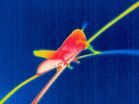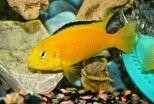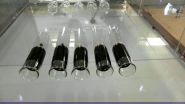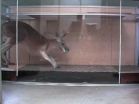(Press-News.org) How do ants manage to move so nimbly whilst coordinating three pairs of legs and a behind that weighs up to 60% of their body mass? German scientists have recently developed a device that may reveal the answer.
Measuring the forces generated by single limbs is vital to understanding the energetics of animal locomotion. However, with very small animals such as insects, this becomes problematic. Dr Reinhardt (Friedrich-Schiller University) used an elastic polycarbonate material to produce a miniature force plate. Springs arranged at right angles to each other enabled forces to be measured across the plate in the micro-Newton range.
The ants (Formica polyctena) walk using an "alternating tripod" system: the front and back legs of one side and the middle leg of the other side move together during one step. It was unknown, however, if a different gait is used for faster running speeds. Ants were made to travel down a runway built on top of the force plate, equipped with a high-speed camera to record a motion sequence. The researchers found that the basic alternating tripod gait did not alter at higher speeds, with the ants instead increasing their stride length and number of steps. The ants appear to adopt a strategy known as "grounded running"; that is, they reach higher speeds without using an "aerial phase" when all joints lose contact with the ground. This improves stability by keeping the centre of mass low, reducing the risk of falling and helping the ants to turn quickly & travel over rough terrain.
The device was also used to investigate ants travelling up a vertical surface. "During level locomotion, the typical vertical force of an ant leg is around 70 µN" Dr Reinhardt described. "The situation is different in vertical climbing. The front legs generate forces as large as the body weight – around 20 mg. We expect that the animals can still generate much larger forces, for instance when transporting food or during fights".
The force plate was built using stereolithography technology. This uses a special photocurable polymer which solidifies when exposed to ultra-violet light. A vat is filled with the liquid polymer and a UV laser scanned across it to build up the structure layer by layer. Because the laser can be set to trace any design, this technology could be used in a wealth of applications. "Our measuring device can be applied far beyond the field of insect biomechanics" Dr Reinhardt stated. "For example, the force plate could be invaluable to the design and testing of micro-robots".
INFORMATION: END
How do ants get around? Ultra-sensitive machines measure their every step…
2014-07-02
ELSE PRESS RELEASES FROM THIS DATE:
Locusts harness the sun to get their optimum diet
2014-07-02
If you are a locust, the most nutritious plant to eat depends on the ambient temperature. Scientists at the University of Sydney, Australia, have discovered that locusts choose their food and then where they digest it according to how hot it is.
Dr Fiona Clissold, who led the study, explains why temperature has such a large influence on insect diets. "Whilst an insect's metabolic rate increases exponentially with temperature, the rate at which locusts absorb protein and carbohydrate from different plants does not increase in step with temperature. As a result, nutrient ...
Smarter than you think: Fish can remember where they were fed 12 days later
2014-07-02
It is popularly believed that fish have a memory span of only 30 seconds. Canadian scientists, however, have demonstrated that this is far from true – in fact, fish can remember context and associations up to twelve days later.
The researchers studied African Cichlids (Labidochromis caeruleus), a popular aquarium species. These fish demonstrate many complex behaviours, including aggression, causing the scientists to predict that they could be capable of advanced memory tasks. Each fish was trained to enter a particular zone of the aquarium to receive a food reward, with ...
A sheep's early life experiences can shape behavior in later life
2014-07-02
New research has found that a sheep's experiences soon after birth can shape its later behaviour and also that of its offspring.
The study led by academics from the University of Bristol's School of Veterinary Sciences and published in the Royal Society journal Biology Letters investigated whether early-life experiences can alter behavioural responses to a naturally painful event in adulthood – giving birth – and also affect behaviour of the next generation.
The period following birth can be a challenging time for young lambs. They are usually tail-docked without analgesia ...
Patients with severe ME have little or no access to specialist treatment services
2014-07-02
One in three severely affected adults with ME in England have no access to local specialist services, new research has shown.
Published in the British Medical Journal Open, the research by the University of Southampton reveals NICE guidelines, which say severely affected patients with ME, otherwise known as chronic fatigue syndrome (CFS), should have access to specialist care, are not being met by many NHS Trusts across England.
Over a third of specialist adult ME/CFS services in the NHS provide no service to severely affected patients, and a further 12 per cent of ...
Nature of solids and liquids explored through new pitch drop experiment
2014-07-02
VIDEO:
The movie clip shows the bitumen flow from the top camera view, and corresponds to approximately 24 days of real time.
Click here for more information.
Physicists at Queen Mary University of London have set up a new pitch drop experiment for students to explore the difference between solid and liquids.
Known as the 'world's longest experiment', the set up at the University of Queensland was famous for taking ten years for a drop of pitch – a thick, black, sticky ...
New study involving CU-Boulder tells the tale of a kangaroo's tail
2014-07-02
VIDEO:
This video is an analysis of video of kangaroos walking has helped scientists discover how important their tails are during locomotion.
Click here for more information.
Kangaroos may be nature's best hoppers. But when they are grazing on all fours, which is most of the time, their tail becomes a powerful fifth leg, says a new study.
Involving researchers at the University of Colorado Boulder, Simon Fraser University in Burnaby, Canada, and the University of New ...
The Lancet: Nearly 80 percent of US deaths in the first three decades of life are due to unintentional injury or violence
2014-07-02
A new report on unintentional injury and violence in the United States, published in The Lancet as part of a new Series, The health of Americans [1], has found that prevention strategies across society show a great deal of promise in preventing unintended deaths and injuries.
According to the report, by CDC researchers from Atlanta, USA, more Americans between the ages of one and 30 die from injury than from any other cause. Every year, nearly 180 000 people in the USA die from preventable causes such as automobile crashes, drowning, firearm-related injuries, falls, ...
The Lancet: Infectious diseases cause significant burden in the USA
2014-07-02
Infectious diseases remain major public health challenges in the United States, according to a new report published in The Lancet as part of a new Series, The health of Americans [1]. Endemic conditions such as chronic viral hepatitis, human immunodeficiency virus, and other sexually transmitted infections continue to affect millions of individuals, with racial and ethnic minorities disproportionately affected. Emerging and re-emerging vector borne and zoonotic disease infections are threatening new areas and populations, as most recently observed with Chikungunya. Despite ...
The Lancet: Chronic disease prevention one of 21st century's key challenges
2014-07-02
According to a report on chronic diseases by Centers for Disease Control and Prevention researchers, published in The Lancet as part of a new Series, The health of Americans [1], half of all adults in the USA suffer from at least one chronic condition, such as diabetes, heart disease, or obesity, and over a quarter of adults have two or more. The majority of these chronic conditions stem from a small number of risk factors that are largely preventable, including tobacco use, poor diet, and physical inactivity (both strongly associated with obesity), alcohol consumption, ...
Predicting the outcome of hepatitis C virus treatment
2014-07-02
Millions of people throughout the world are infected with hepatitis C virus (HCV), which can lead to cirrhosis of the liver and cancer. Directly acting antiviral agents inhibit viral proteins and have been used to successfully treat HCV. Unfortunately, antiviral therapy fails in some patients, resulting in a relapse of HCV. A study published in the Journal of Clinical Investigation identifies a marker that can identify patients likely to have an HCV relapse after antiviral therapy. Shyamasundaran Kottilil and colleagues at the NIH evaluated the immune response of HCV-infected ...



